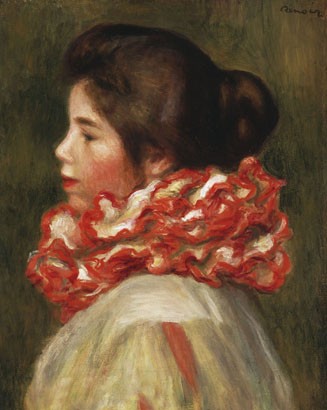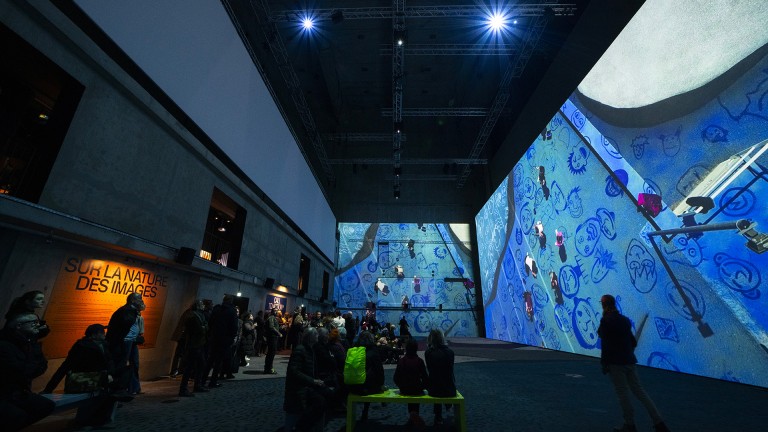Renoir in the 20th Century
From 23 September 2009 To 4 January 2010
- Description
- Schedule
- Prices
To be shown at the Los Angeles County Museum Of Art from 14 February to 9 May 2010 then in the Philadelphia Museum of Art from 12 June to 5 September 2010.
"I'm starting to know how to paint. It has taken me over fifty years' work to get this far and it's not finished yet," declared the artist Pierre-Auguste Renoir (1841-1919) in 1913, at a time when a major exhibition of his work, including the large nudes painted at the turn of the twentieth century, was on show at the Bernheim Jeune gallery in Paris. It was a revelation.
Guillaume Apollinaire was lavish in his praise for the man he considered "the greatest living painter": "Renoir grows greater all the time. His latest paintings are always the most beautiful. And the most youthful."
"Imperishable youth" indeed, to quote an admiring remark made in 1896 by Thadée Natanson, who saw Renoir enjoying unchallenged prestige on the art scene in the early twentieth century. He was acclaimed as an emblematic figure of Impressionism in the 1870s but he was also admired for being able to go further and renew a movement that was already winning wider acceptance. Like his contemporaries and friends Paul Cézanne and Claude Monet, Renoir was a reference for the new generation of artists. Pablo Picasso, Henri Matisse, as well as Pierre Bonnard or Maurice Denis expressed their admiration for the master and in particular for his “last manner”, referring to his work at the turn of the century. Great admirers of modern art such as Leo and Gertrude Stein, Albert Barnes, Louise and Walter Arensberg or again Paul Guillaume, collected Renoir alongside Cézanne, Picasso and Matisse.
Since then, appreciation of "the late Renoir" has changed somewhat: the paintings from this period are now little-known and often not particularly liked. Although his landscapes ("Renoir's Landscapes 1865-1883", London-Ottawa-Philadelphia 2007-2008) and portraits ("Renoir's Portraits", Ottawa-Chicago-Fort Worth 1997-1998) have given rise to exhibitions in recent years, there have been no studies or exhibitions focusing specifically on Renoir's last years, as was the case for Monet or Cezanne ("Monet in the 20th century", Boston-London, 1998-1999; "Cezanne, the last years (1895-1906)", Paris -New York, 1978). This exhibition is dedicated to the exploration of these fertile years.
After fighting for Impressionism, Renoir challenged the basic principles of the movement about 1888 and concentrated on drawing and studio work in an overt reference to the past. This period of crisis and research ended at the beginning of the 1890s, a decade which brought Renoir public and institutional recognition and commercial success. Without rejecting Impressionism, Renoir then invented a style that he claimed was classical and decorative. As a self-styled "figure painter", Renoir concentrated on female nudes, portraits and studies from models, in the studio or in the open air, and experimented with new techniques.
An artist who was forever exploring and keen to take up challenges, Renoir wanted to test himself against great masters from the past, such as Raphael, Titian and Rubens, whom he had admired in the Louvre or during his travels. His research was driven by his rejection of the modern world and a preference for a timeless Arcadia, peopled by sensual bathers and inspired by the South of France where he stayed often from the 1890s onward. He saw the Mediterranean landscape as an antique land, at once the cradle and last refuge of a living, familiar and topical mythology. Renoir stubbornly returned to a narrow group of themes which he readily explored in unaccustomed techniques, such as sculpture. In the first decade of the twentieth century, his work from life and from models led to new compositions, of which the Odalisques and, above all, the {Large Bathers} of 1918-1919 (Paris, Musee d'Orsay) were the crowning glory.
Did not Renoir himself call the {Bathers} "an achievement" and "a springboard for future research"? That was how the painting was seen by a number of artists in France in the early twentieth century, in the often controversial context of the development of Cubism and abstraction: Renoir had found a balance between objectivity and subjectivity, between tradition and innovation, which led to classical modernity.
So the exhibition has a twofold aim: it seeks to explore a period and aspects of Renoir's work which are little known to the public (decorative painting, drawings, sculpture…) while demonstrating his influence on other artists in France in the first half of the twentieth century. The exhibition will bring together about a hundred of Renoir's paintings, drawings and sculptures, from public and private collections all over the world. Some of these nudes, portraits and studies of models once belonged to Matisse or Picasso. Spread over some fifteen sections, they will occasionally be shown alongside works by Picasso, Matisse, Maillol or Bonnard, as a testimony to Renoir's posterity. In this way, the exhibition is an invitation to review the last Renoir by seeing how these artists from the first half of the twentieth century looked at a nineteenth-century master, who happened to be their contemporary.
Curator:
-
Galeries nationales
du Grand Palais, Paris:
Curator: Sylvie Patry, curator, Musée d'Orsay
Curator for the section “Documents around Renoir”: Isabelle Gaëtan, research officer, Musée d'Orsay
Curator for sculpture: Emmanuelle Héran, curator, assistant to the general director of the Réunion des Musées Nationaux
-
Los Angeles County Museum of Art
(LACMA), Los Angeles:
Claudia Einecke, curator, LACMA and J.Patrice Marandel, curator in chief, LACMA
-
Philadelphia Museum Of Art
, Philadelphia:
Joseph J. Rishel, the Gisela and Dennis Alter Senior Curator of European Painting, Philadelphia Museum of Art and Jennifer Thompson, curator, Philadelphia Museum of Art
Exhibition design:
Pascal Rodriguez, architect
Useful Information
Address
Galeries nationales du Grand palais
Entrance Champs-Elysées
3, avenue du Général Eisenhower
75008 Paris
Access
M° 1, 9, 13 : Franklin-Roosevelt or Champs-Elysées Clemenceau
Audioguide
5 €
French, English, German, Spanish, Italian
Rmn Publications
exhibition catalogue: 464 pages, 49 €
Everyday except Tuesdays from 9:30am to 10pm, Wednesdays from 10am to 10pm, Thursdays from 8am to 10pm
During the school holidays: from 24th October to 8th November, and from 19th December to 3th January: open everyday from 9am to 11pm Tuesdays included.
Closed on 25th december.


